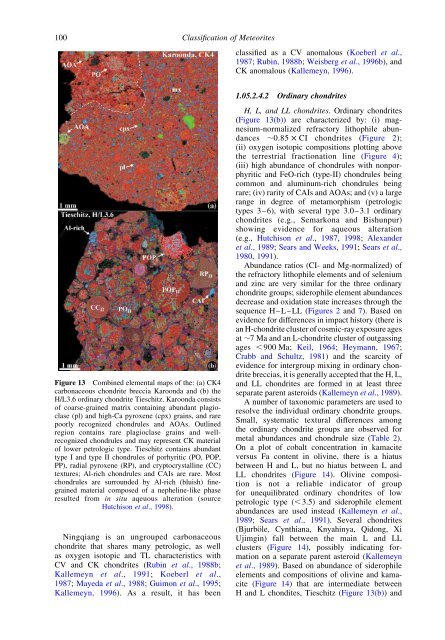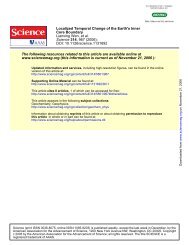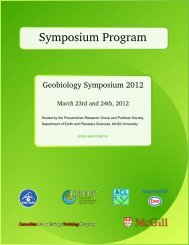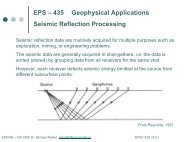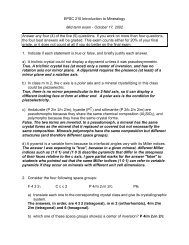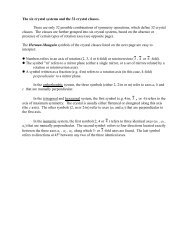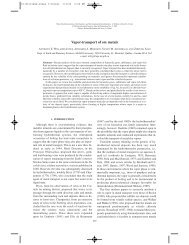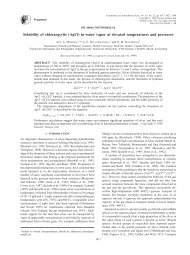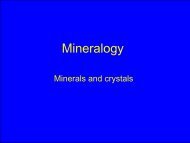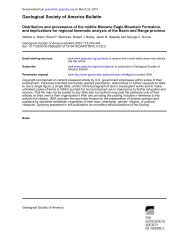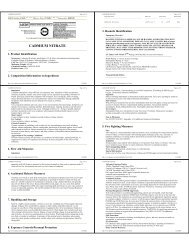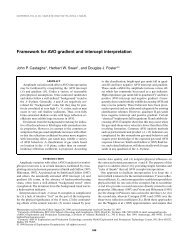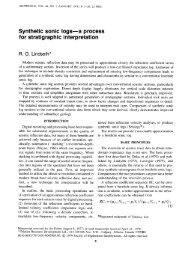05 Classification of.. - Department of Earth and Planetary Sciences
05 Classification of.. - Department of Earth and Planetary Sciences
05 Classification of.. - Department of Earth and Planetary Sciences
You also want an ePaper? Increase the reach of your titles
YUMPU automatically turns print PDFs into web optimized ePapers that Google loves.
100<br />
<strong>Classification</strong> <strong>of</strong> Meteorites<br />
classified as a CV anomalous (Koeberl et al.,<br />
1987; Rubin, 1988b; Weisberg et al., 1996b), <strong>and</strong><br />
CK anomalous (Kallemeyn, 1996).<br />
Figure 13 Combined elemental maps <strong>of</strong> the: (a) CK4<br />
carbonaceous chondrite breccia Karoonda <strong>and</strong> (b) the<br />
H/L3.6 ordinary chondrite Tieschitz. Karoonda consists<br />
<strong>of</strong> coarse-grained matrix containing abundant plagioclase<br />
(pl) <strong>and</strong> high-Ca pyroxene (cpx) grains, <strong>and</strong> rare<br />
poorly recognized chondrules <strong>and</strong> AOAs. Outlined<br />
region contains rare plagioclase grains <strong>and</strong> wellrecognized<br />
chondrules <strong>and</strong> may represent CK material<br />
<strong>of</strong> lower petrologic type. Tieschitz contains abundant<br />
type I <strong>and</strong> type II chondrules <strong>of</strong> porhyritic (PO, POP,<br />
PP), radial pyroxene (RP), <strong>and</strong> cryptocrystalline (CC)<br />
textures; Al-rich chondrules <strong>and</strong> CAIs are rare. Most<br />
chondrules are surrounded by Al-rich (bluish) finegrained<br />
material composed <strong>of</strong> a nepheline-like phase<br />
resulted from in situ aqeuous alteration (source<br />
Hutchison et al., 1998).<br />
Ningqiang is an ungrouped carbonaceous<br />
chondrite that shares many petrologic, as well<br />
as oxygen isotopic <strong>and</strong> TL characteristics with<br />
CV <strong>and</strong> CK chondrites (Rubin et al., 1988b;<br />
Kallemeyn et al., 1991; Koeberl et al.,<br />
1987; Mayeda et al., 1988; Guimon et al., 1995;<br />
Kallemeyn, 1996). As a result, it has been<br />
1.<strong>05</strong>.2.4.2 Ordinary chondrites<br />
H, L, <strong>and</strong> LL chondrites. Ordinary chondrites<br />
(Figure 13(b)) are characterized by: (i) magnesium-normalized<br />
refractory lithophile abundances<br />
,0.85 £ CI chondrites (Figure 2);<br />
(ii) oxygen isotopic compositions plotting above<br />
the terrestrial fractionation line (Figure 4);<br />
(iii) high abundance <strong>of</strong> chondrules with nonporphyritic<br />
<strong>and</strong> FeO-rich (type-II) chondrules being<br />
common <strong>and</strong> aluminum-rich chondrules being<br />
rare; (iv) rarity <strong>of</strong> CAIs <strong>and</strong> AOAs; <strong>and</strong> (v) a large<br />
range in degree <strong>of</strong> metamorphism (petrologic<br />
types 3–6), with several type 3.0–3.1 ordinary<br />
chondrites (e.g., Semarkona <strong>and</strong> Bishunpur)<br />
showing evidence for aqueous alteration<br />
(e.g., Hutchison et al., 1987, 1998; Alex<strong>and</strong>er<br />
et al., 1989; Sears <strong>and</strong> Weeks, 1991; Sears et al.,<br />
1980, 1991).<br />
Abundance ratios (CI- <strong>and</strong> Mg-normalized) <strong>of</strong><br />
the refractory lithophile elements <strong>and</strong> <strong>of</strong> selenium<br />
<strong>and</strong> zinc are very similar for the three ordinary<br />
chondrite groups; siderophile element abundances<br />
decrease <strong>and</strong> oxidation state increases through the<br />
sequence H–L–LL (Figures 2 <strong>and</strong> 7). Based on<br />
evidence for differences in impact history (there is<br />
an H-chondrite cluster <strong>of</strong> cosmic-ray exposure ages<br />
at ,7 Ma <strong>and</strong> an L-chondrite cluster <strong>of</strong> outgassing<br />
ages ,900 Ma; Keil, 1964; Heymann, 1967;<br />
Crabb <strong>and</strong> Schultz, 1981) <strong>and</strong> the scarcity <strong>of</strong><br />
evidence for intergroup mixing in ordinary chondrite<br />
breccias, it is generally accepted that the H, L,<br />
<strong>and</strong> LL chondrites are formed in at least three<br />
separate parent asteroids (Kallemeyn et al., 1989).<br />
A number <strong>of</strong> taxonomic parameters are used to<br />
resolve the individual ordinary chondrite groups.<br />
Small, systematic textural differences among<br />
the ordinary chondrite groups are observed for<br />
metal abundances <strong>and</strong> chondrule size (Table 2).<br />
On a plot <strong>of</strong> cobalt concentration in kamacite<br />
versus Fa content in olivine, there is a hiatus<br />
between H <strong>and</strong> L, but no hiatus between L <strong>and</strong><br />
LL chondrites (Figure 14). Olivine composition<br />
is not a reliable indicator <strong>of</strong> group<br />
for unequilibrated ordinary chondrites <strong>of</strong> low<br />
petrologic type (,3.5) <strong>and</strong> siderophile element<br />
abundances are used instead (Kallemeyn et al.,<br />
1989; Sears et al., 1991). Several chondrites<br />
(Bjurböle, Cynthiana, Knyahinya, Qidong, Xi<br />
Ujimgin) fall between the main L <strong>and</strong> LL<br />
clusters (Figure 14), possibly indicating formation<br />
on a separate parent asteroid (Kallemeyn<br />
et al., 1989). Based on abundance <strong>of</strong> siderophile<br />
elements <strong>and</strong> compositions <strong>of</strong> olivine <strong>and</strong> kamacite<br />
(Figure 14) that are intermediate between<br />
H <strong>and</strong> L chondites, Tieschitz (Figure 13(b)) <strong>and</strong>


